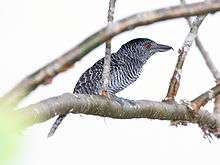Fasciated antshrike
| Fasciated antshrike | |
|---|---|
 | |
| Male in Panama | |
_-Panama-6-4c.jpg) | |
| Female in Panama | |
| Scientific classification | |
| Kingdom: | Animalia |
| Phylum: | Chordata |
| Class: | Aves |
| Order: | Passeriformes |
| Family: | Thamnophilidae |
| Genus: | Cymbilaimus |
| Species: | C. lineatus |
| Binomial name | |
| Cymbilaimus lineatus (Leach, 1814) | |
The fasciated antshrike (Cymbilaimus lineatus) is a species of bird in the antbird family Thamnophilidae. The species is found in Central and Southern America.
Taxonomy and systematics
The species is very closely related to the bamboo antshrike, and the two have previously been considered to be the same species. As the entire range of that species is shared with the fasciated antshrike, however, the two are now treated as two species. The fasciated antshrike has three subspecies, ' the nominate subspecies, C. l. lineatus , C. l. fasciatus (Ridgway, 1884) and C. l. intermedius (Hartert & Goodson, 1917).[2]
Distribution and range
It is found from eastern Honduras down to Colombia, the Amazon Basin and the Guyanas. Its natural habitat tropical moist lowland forests, in tangled and dense vegetation in the mid-story of the forest. It is more common in secondary forest in Central America. It is usually found below 800 m (2,600 ft) and rarely up to 1,600 m (5,200 ft) . Where its range overlaps with that of the bamboo antshrike it is found at lower elevations than that species.[2]
Description
The fasciated antshrike is a large antbird, 17 to 18 cm (6.7–7.1 in) long and weighing 35–40 g (1.2–1.4 oz). The plumage varies by sex (sexual dimorphism), with the male being black with white barring across the whole body. The barring is very faint on the crown and becomes more even further down the body. The crown is rufous on the female, and the rest of the body is brown bared with faint yellow-brown, become yellow-brown barred with brown further down the body. The bill is large and hooked.[2]
The fasciated antshrike makes a variety off calls, including lazy plaintive whistles and a rattle-like chatter.[2]
Behaviour
Diet and feeding
The fasciated antshrike feeds on large insects and other prey in the mid-story, from 5–20 m (16–66 ft) off the ground. It particularly feeds on vine clusters and near tree trunks, but will also come down to the forest floor on occasion. Insects taken include grasshoppers, bugs, beetles and caterpillars, as well as spiders and even lizards, amphibians and occasionally fruit. They will join mixed species feeding flocks with antwrens and foliage-gleaners that pass through their territories, and will also follow army ants to take prey flushed by them, but they are not obligate ant-followers.[2]
Breeding
Two creamy white eggs with variable patterning are laid in a simple cup nest of plant fibres placed 2–10 m (6.6–32.8 ft) off the ground. Both parents incubate the eggs during the day, only the female does so at night.[2]
References
- ↑ BirdLife International (2012). "Cymbilaimus lineatus". IUCN Red List of Threatened Species. Version 2013.2. International Union for Conservation of Nature. Retrieved 26 November 2013.
- 1 2 3 4 5 6 Zimmer, K. & Isler, M.L. (2017). Fasciated Antshrike (Cymbilaimus lineatus). In: del Hoyo, J., Elliott, A., Sargatal, J., Christie, D.A. & de Juana, E. (eds.). Handbook of the Birds of the World Alive. Lynx Edicions, Barcelona. (retrieved from http://www.hbw.com/node/56646 on 13 March 2017).
